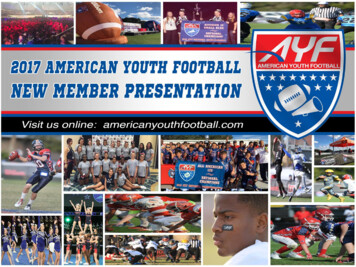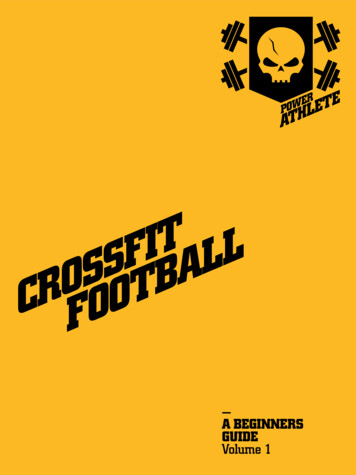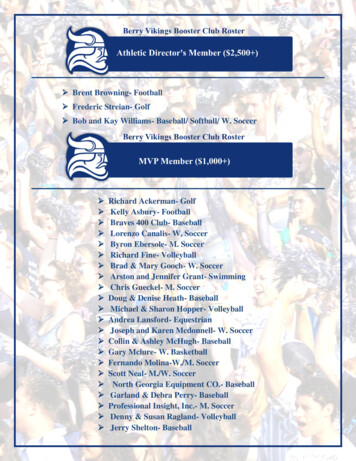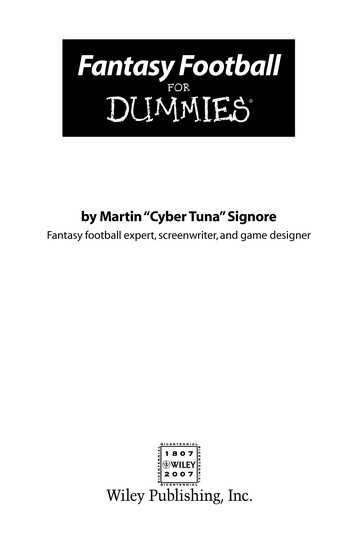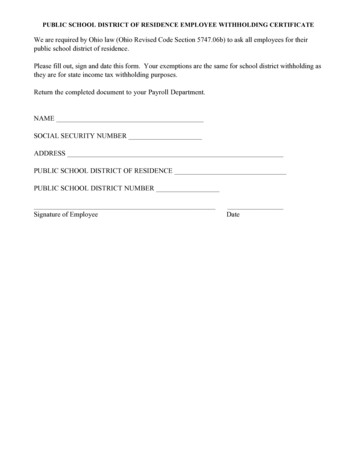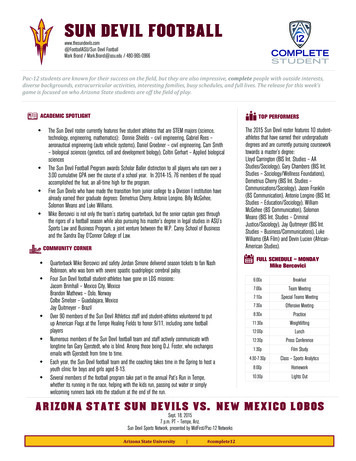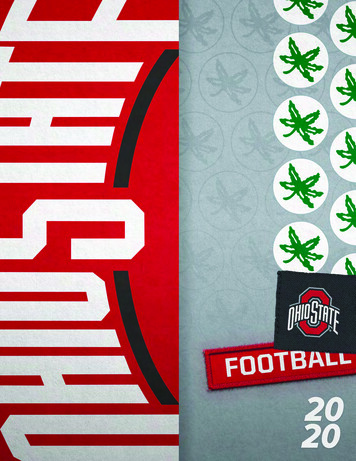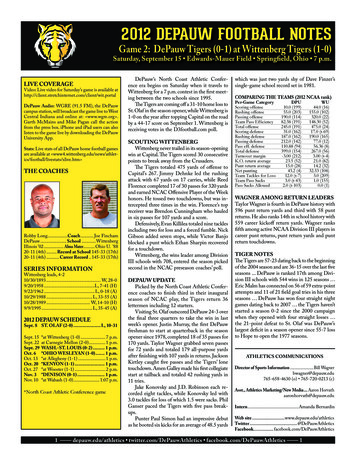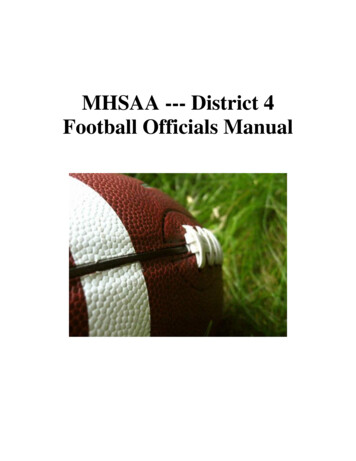
Transcription
MHSAA --- District 4Football Officials Manual
MHSAA --- District 4 Football Officials Manual1.2.3.4.5.6.7.8.Officiating RequisitesCharacterConduct and EthicsOfficiating axiomsUniformsPhilosophiesPre-game responsibilitiesMechanics Free Kicks Scrimmage Kicks Scoring Kicks Scrimmage Playsi. Before the snapii. Running play Coverageiii. Goal line coverageiv. Forward pass coveragev. Knowing and reading keys Penalty Enforcements Time Out Management Line To Gain Measurements End of First and Third Periods Overtime Bean bag usage Approved supplemental signalspage 1page 2page 2page 4page 5page 6page 10page 13page 13page 17page 19page 21page 21page 23page 25page 27page 29page 34page 38page 40page 41page 41page 42page 42
1. Officiating RequisitesCourage, knowledge of the rules & mechanics, hustle and tact are indispensable to a goodofficial, but none is of any more importance that the prime requisite – GOODJUDGEMENT!Unfailing familiarity with the rules and full understanding of mechanics are necessary forthe proper conduct of a game but are no guarantee of optimum performance. The intentof each rule must be kept in mind. Situations arise in a game that cannot be covered in arulebook or manual. FOOTBALL SENSE MUST SUPERSEDE TECHNICALAPPLICATION OF THE RULES.Courage – While football officiating requires courage, a smooth running gamesuddenly can get out of hand as a result of a domineering attitude toward players andcoaches. Conversation with a player or coach should always be courteous, but withoutsacrificing dignity. If an action warrants a foul being called, it should be done and thepenalty for the foul administered unobtrusively and without dramatization. A game iskept under control by proper administration of the rules. No impression of militantsupervision should be displayed.Knowledge – Rule mastery must be thorough and supplemented by an ability tointerpret rules correctly. Attempting to officiate without these skills is unfair to everyoneconcerned. These abilities are acquired only through devotion of time and study.Anyone unable or unwilling to acquire these skills should leave officiating.Hustle – Hustle is of the utmost importance. Hustle keeps officials in the bestand proper position to make a call. When officials hustle to be in that position ahead ofhaving to make a call, he ‗sells‘ his call by not being ‗on the move‘ at the time it has to bemade. Hustle in the times of .dead ball intervals, between periods, positioning for ascrimmage or free kick exhibits that official‘s desire to be on the field and part of thegame.Tact – Tact is necessary but submission is not. Tact should never be ajustification for retreating from a position properly taken or a decision correctly rendered.Poise -- Be a calming influence amidst the turmoil that is a football game.Staying calm is an asset in officiating, as in any other phase of a sport where fast reflexesare required. A relaxed appearance is a great help as it gives the impression ofconfidence. Care, however, should be taken to avoid the appearance of indifference. Thepoised official is able to remain inconspicuous as he moves to be in the right place at theright time.Physical Condition – Football officiating is difficult, exhausting and requiresefficiency of mind and body. Men whose eyes, lungs or legs are not in sound conditionhave no place in officiating. Officials who need eyeglasses or contact lens should use1
them. It is recommended that each official obtain a physical examination prior to eachseason.Mental Reactions / Abilities – Decisions should be made timely and a rulingshould be announced with a minimum of delay, whenever possible. Officials must beable to maintain total concentration for the full 48 minutes of the game (plus overtimeperiods if required).Duties and Responsibilities – Each official must have thorough knowledge ofthe duties / mechanics of his own position. He must also be fully informed concerningthe duties of each of the other officials. Be prepared to assume any one of the otherpositions should circumstances require changing positions. An official must:A.B.C.D.E.F.G.H.Know the down and distance prior to each snap.Be ready to assist a crewmate who is temporarily out ofposition.Be aware of erroneous procedure or rulings and attempt toprevent and correct whenever possible.Know the prescribed signals and when and how they shouldbe used.Secure a new ball if appropriate, after all action has ceasedand be able to handle and pass the ball properly.Be alert to happenings away from the ball when play has lefthis immediate area. (Be a good dead ball official)Call time-out for any player who is obviously injured ordisable.Call any foul or rule infraction (if it impacts the play or puts aplayer in jeopardy) regardless of specific assignment.Cooperation -- Teamwork is essential among crewmates. Continuous verbalcommunication between all officials during the game is essential for effectivegame administration.Confidentiality – Do not discuss with any coach the play or players of hisopponents in a game that you will officiate or are officiating. Caution should beused in discussing any team, players or coaches in all your daily activities.Hospitality – In most high school settings the host school exhibits great effort toaccommodate and welcome game officials. Care should be exercised to avoid theappearance of fraternization at the game site. The officials are assigned to a gamefor one purpose: to officiate the contest at hand.2
2. CharacterRealize the importance of your position and at all times uphold the dignity it demands.Have ambition, but also patience, as over anxiety has ruined many young officials.Never use your senior position to embarrass another official.Be receptive. Open your mind to new concepts and ideas.Become a leader. If you adopt a philosophy that you are going to help others reach theirgoals, you will reach yours.Be passionate. If you are passionate about integrity, honest and professionalism, you‘veimproved your quality of life through officiating.Be courageous. Doing what is right – versus what‘s popular or safe – takes strong willand conviction.3. Conduct and EthicsOfficials shall bear a great responsibility for creating public confidence in sports.Officials shall be free of obligation to any interest other than the impartial and fairjudging of sports competitions.Officials shall hold and maintain the basic tenets of officiating which include history,integrity, neutrality, respect, sensitivity, professionalism, discretion and tactfulness.Officials shall master both the rules of the game and mechanics necessary to enforce therules, and shall exercise authority in an impartial, firm and controlled manner.Officials shall uphold the honor and dignity of the avocation in all interactions withstudent athletes, coaches, school administration, colleagues and the public.Officials shall display and execute superior communications skills, both verbal and nonverbal.Officials shall prepare themselves both physically and mentally and shall presentthemselves in a manner consistent with the high standards of the avocation.Officials shall be punctual and professional in the fulfillment of all obligations.Officials shall work with each other, elected district leaders and the MHSAA in aconstructive and cooperative manner.3
Officials shall accept responsibility for all actions taken.4. Officiating AxiomsWe want quality fouls, see everything you call, but don‘t call everything you see.Other than a cheap shot, a foul that is called should be at the point of attack and have amaterial effect on the play.If you think you saw something, you didn‘t see it.Continue to officiate after throwing the flag, the play is probably not over.Players can (and should) stop on the whistle, however, officials cannot.Be a good dead ball official. View all players until they are back with their teammates.Have a slow whistle – remember the play will kill itself.Only the covering officials of the zone where the ball becomes dead should sound theirwhistles to signify the play is over. A whistle may be needed to stop activity away fromthe end of the run, but remember your presence, with voice commands, can be used tostop this activity as well.Too many officials blowing whistles could mean we are watching the ball and not ourarea of responsibility.Have excellent communication with other officials, coaches and players, always usingcourtesy.Preventive officiating is a beautiful thing.If you know a mistake has been made – stop the game. We must correct what iscorrectable.Be mentally and physically prepared to work the game.Have a routine progression for each dead ball period between plays.Three C‘s of every play; Confirm down and distance, Count players (don‘t assume 11),ConcentrateWhile on the field, move with a purpose, no walking.4
Keep hustling at all times, but know the difference between hustle and hurry.If all else fails, a little common sense goes a long way.Flag on the ground, means it is time to slow down. Take adequate time to get penaltyadministration correct.Imagine the coach with yellow flag in his pocket that he can only use to callUnsportsmanlike Conduct on us. Never give him a reason to use it.5. UniformsOfficials should constantly be aware of the condition of all segments of his officiatinguniform and obtain new pieces as necessary to present a sense of pride and decorum inhis appearance on the field of play.Approved uniform for MHSAA District Four officials:Shirt – Standard black and white knit, long tail, 1-inch vertical striped short or longsleeve shirt. All crew members shall match by wearing either short or long sleeve shirts.If long sleeves are worn, sleeves shall be worn at the wrist. (not pushed up to elbow).Then MHSAA patch shall be worn above the pocket. An American Flag patch may beworn on the left sleeve, but only if all crew members wear one.Pants – Standard black pants with a 1 ¼ inch white stripe down the outside of both legs.Undershirts – All undershirts that will be visible shall be black.Socks – Shall be solid black.Shoes and belt – Shoes should be predominantly black (limited amount of white forlogos or stripes) and maintained at a proper shine. Shoe laces shall be black. Belt shallbe black and its width a minimum of 1 ¼ inches with a maximum of 2 inches.Cap – All caps shall be fitted (sized) Adjustable caps are NOT acceptable. Referee –solid white cap. All other positions – black cap with white piping.Foul Marker – All crew members shall be equipped with a light gold foul marker,15‖x15‖ and weighted in the center. Marker shall be carried INCONSPICUOUSLY andout of sight.Bean Bag – All officials shall be equipped with a bean bag for marking spots. Approvedcolors are white, royal blue and black. All crew members shall have the same color beanbag.5
Whistle – If a whistle on a lanyard is used, both must be black. If a finger whistle is usedit also should be black.Jackets – Jackets are not considered part of the approved uniform. They may be wornduring pre-game responsibilities.Gloves – If gloves are worn they should be predominantly black.Towel – Umpire is allowed to utilize a towel for assistance in maintaining a dry ball forplay. Towel shall be black, worn on the belt and not exceed 8‖x12‖ in visible area.Other approved and suggested auxiliary equipment include: an elastic down indicator orother device to keep track of downs, a coin for the referee, a device that is clipped to thechain to aid in measurements for the Head Linesman, a countdown style wristwatch withblack band for officials with timing responsibilities. Also approved are devices worn onthe belt for play clock and time out management.6. PhilosophiesBall SpottingThe ball can be spotted on a yard line to begin the next series after a change of possessionFor example, if a punt return ends between the 33 and 34 yard line, the ball may bemoved up to the 34 yard line to begin the new series. (Exception: if change of possessionis after a fourth down running or passing play, the ball will be left at the dead ball spot tobegin the next series)Line of scrimmageWhen in question, the formation is legal.Officials will work to keep offensive linemen legal and will call only when obvious orwhen a warning to the player and a subsequent warning to the coach are ignored. Don‘twait till the fourth quarter to enforce the ruleIf an ineligible offensive player is lined up with his head clearly behind the rear of thesnapper, a foul will be called without a warning.Don‘t be too technical on an offensive player who is a wide receiver or slot back whendetermining if he is off or on the line of scrimmage. When in question, it is not a foul.Wide receivers or slot backs lined up outside a tight end will be ruled on the line ofscrimmage and covering the tight end if there is no stagger between their alignment. If inquestion, he is not covered up.Formations during the execution of a trick or unusual play have the highest degree ofscrutiny and should be completely legal.6
Remember, illegal formation is a live ball foul; flag is dropped at the snap.When in question, a quick or abrupt movement by the snapper or the quarterback is afalse start.When in question, the formation is legal.FumblesWhen in question, the runner was down and did not fumble.When in question regarding whether the quarterback passed or fumbled, it will be ruledan incomplete pass.Defensive Pass InterferenceActions that constitute DPI include, but are not limited to the following categories:Early contact by a defender who is not playing the ball is DPI provided the otherrequirements for DPI have been met, regardless of how deep the pass is thrown to thereceiver.Playing through the back of a receiver in an attempt to make a play on the ball.Grabbing and restricting a receiver‘s arm(s) or body in such a manner that restricts hisopportunity to catch a pass.Extending an arm across the body (arm bar) of a receiver thus restricting his ability tocatch a pass, regardless of the fact of whether or not the defender is looking for the ball.Cutting off or riding the receiver out of the path to the ball by making contact with himwithout playing the ball.Hooking and restricting a receiver in an attempt to get to the ball in such a manner thatcauses the receiver‘s body to turn prior to the ball arriving.Offensive Pass InterferenceActions that constitute OPI include but are not limited to the following categories:Initiating contact with a defender by shoving or pushing off thus creating separation in anattempt to catch a pass.Driving through a defender who has established a position on the field.Blocking downfield during a pass that legally crosses the line of scrimmage.7
Picking off a defender who is attempting to cover a receiver.Not Offensive Pass InterferenceOPI for blocking downfield will not be called on a screen pass when the ball isoverthrown behind the line of scrimmage but subsequently lands beyond the expandedline of scrimmage and linemen are blocking downfield , unless such blocking prevents adefender from catching the ball.It is not OPI on a pick play if the defensive player is blocking the offensive player whenthe pick occurs and the offensive player doesn‘t make a separate action.Other Passing SituationsWhen in question on action against the passer, it is roughing the passer if it is judged thedefender‘s intent is to punish.If the passer is contacted after he starts his passing motion, it may be ruled no intentionalgrounding due to this contact.If the passer is contacted clearly before he starts his passing motion, there will be a foulfor intentional grounding if there is no eligible receiver in the vicinity.If an interception is near the goal line and there is a question as to whether possession isgained in the field of play or in the end zone, make it a touchback.BlockingTakedowns at the point of attack, those in the open field and affecting the result of theplay create special focus and should be called as holding.If there is a potential offensive holding but the action occurs clearly away from the pointof attack and has no (or could have no) effect on the play, offensive holding should not becalled.If there is a potential defensive holding but the action occurs clearly away from the pointof attack and has no (or could have no) effect on the play, defensive holding should notbe called. Example: a defensive back on the opposite side of the field holding a widereceiver on a designed run play to the other side.If the force of a block is clearly on the side it is not a foul.The force of a block could be slight and still be a foul if the contact is in the back andpropels the player past the runner or prevents him from making the play.8
For blocks in the back, if one hand is on the number and the other hand is on the side andthe initial force is on the number, it is a block in the back.Blocks that start on the side and subsequently end up in the back are not fouls as long ascontact is maintained throughout the block.Blocks in the back and offensive holds that occur at or about the same time as the runneris being tackled shall not be called.Blocks in the back that are personal fouls in nature should be called regardless of theirtiming relative to the runner being tackled.A grab of the receiver‘s jersey that restricts the receiver and takes away his feet should bedefensive holding if other criteria are met, and could be DPI.Holding can be called even if the quarterback is subsequently sacked as it may be theother half of an offset foul.Rarely should you have a hold on a double team block unless there is a takedown or thedefender breaks the double team and is pulled back.Kicking PlaysIt shall always be roughing the kicker when there is forcible contact to the plant leg,whether or not that leg is on the ground. It shall be running into the kicker if a defendersimply ‗runs through‘ the kicking leg. All other contact shall be based on the severityand the potential for injury to the kicker.When in question, a foul by the receiving team on a scrimmage kick occurs after the ballis kicked.Illegal block in the back can be called on fair catches, but not if the illegal block occursaway from the play as the fair catch is being made, or the play results in a touchback andthe contact is slight. (Note: Personal fouls should always be called)Blocks in the back that are personal fouls should be called regardless of their timingrelative to a fair catch.The kicker‘s restraining line on onside kicks should be officiated as a plane. Any player(other than the kicker or holder) breaking the plane before the ball is kicked should becalled for offside. The same plane applies on ―normal‖ kickoffs, but officials should notbe too technical in regard to breaking the plane.On kicks entering the end zone or not, when in question, the kick has broken the planeand is a touchback.9
Scoring PlaysWhen in question, it is not a touchdown.When in question, it is not a safety.A non-airborne runner crossing the goal line inside the pylon with the ball crossing thegoal line extended is a touchdown.Plays at the sidelineIf legal contact occurs before the runner has a foot down out of bounds, consider it a legalhit.If the whistle has blown and a runner continuing to advance down the sideline has easedup, contact by the opponent against the runner is a foul. Officials should be alert and besure any action is not part of the initial play before calling a foul.When in question as to whether the runner stepped out of bounds, officials should rule therunner did not step out of bounds.Personal FoulsIf action is deemed to be ―fighting‖, the player must be disqualified.When in question if an act is a flagrant personal foul or fighting, the player is notfighting.Players committing flagrant personal fouls must be disqualified.When in question regarding hits away from the ball near the end of the play, consider it adead-ball rather than a live-ball foul.7. Pre-game ResponsibilitiesOfficials should be dressed and on the field one hour prior to kickoff, earlier, if possible,especially if both teams are on the field.Meeting for coin toss should take place as soon as game administrator and both headcoaches are available, but no later than 35 minutes prior to kickoff.The meeting with coaches should be held at center of the 50 yard line with all officialsattending.Prior to the coaches meeting officials should be positioned as follows to observe fieldconditions, player equipment legality, QB throwing arms, leg strengths of kickers /punters, play formations and as a separation of teams on the respective 45 yard lines.10
R, U and T spread along the 50 yard line, maintaining team separationH / S on the visitor sideline, at opposite 25 yard lines, observing teamsL / F on the home sideline, at opposite 25 yard lines, observing teamsAfter coaches meeting / coin toss H and L walk away with respective coaches to receiveinformation from coaches regarding unusual formations or plays they intend to use orother concerns they may need to share with officials.R, U and T return to 50 yd line.S / F return to positions along the sidelines.When the discussions with coaches have completed, H / L assume R / U positions on the50.R / U circle the field observing field markings, pylon placement, try for point three yardmarks. Report any issues to game manager for correction if possible.Return to original positions when R / U complete playing field observations.Sideline officials can move to one side of the fifty if only one team remains on the field.11
Crew may elect to exit field if the home team is the single team on the field.If the site does not have facility away from the field in which the crew can meet andcover final pregame mechanics and any information H / L gathered from coaches, thenmeet as a group in the most inconspicuous corner available, so as to not draw attention tothe crew.H will meet and review responsibilities with line to gain chain crew and down boxoperator.U will inspect and approve game balls.S / F will meet with ball boys with instructions for managing game balls throughout thegame. Ball boys are not to come onto the field of play.S / F will retrieve game captains from locker rooms with enough time to present them atmidfield at 5:00 minutes before kickoffH / L will maintain sideline control at the ‗Numbers‖ (9 yd marks) S / F will join themthere after captain presentation.After ceremonial coin toss all officials meet at mid field for final instructions prior tomoving to free kick positions.12
8. MechanicsFree KicksPositioning and KeysReferee – Starting position is in the middle of the field a minimum of five yards behindthe deepest receiver. Be alert for touchbacks.Head Linesman -- Starting position is on the sideline opposite the press box at R‘s goalline. You have goal line and pylon responsibility. Your key is the K player nearest thesideline on your side. Move quickly to zone coverage if kick is to your side of field.Line Judge – Starting position is on the sideline on the press box side at team R‘s goalline. You have goal line and pylon responsibility. Your key is the K player nearest thesideline on your side. Move quickly to zone coverage if kick is to your side of field.Side Judge – Assist in clearing the sideline of players and coaches. Starting position ison the sideline opposite the press box on team R‘s restraining line. Your keys are Kplayers 2, 3 and 4 on your side of the field (note you should know their numbers).Ensure there are at least four K players on each side of the kicker.Field Judge – Assist in clearing the sideline of players and coaches. Starting position ison the sideline on the press box side on team R‘s restraining line. Your keys are Kplayers 2, 3 and 4 on your side of the field (note you should know their numbers).Ensure there are at least four K players on each side of the kicker.13
Umpire – Assist in clearing the sidelines. Before handing the ball to the kicker, identifythe Referee for the kicker; instruct him to wait on the R‘s ready for play whistle beforekicking the ball. Then move to your starting position on the press box sideline at teamK‘s restraining line. Umpire‘s keys are the middle three K players. This will include thekicker, whose protection is your responsibility. Ensure all K players are within five yardsof the K restraining line.Free Kick CoverageAll – Once the ball is kicked, observing the players is your primary responsibility. Do notfocus on the flight of the ball.Referee – When players and officials are ready and after the Umpire has reached thesideline after handing the ball to the kicker, sound your whistle and give the ready forplay signal. Move laterally to be in position to see action at the point of attack. You areprimarily responsible for illegal blocks at the point of attack. Follow the play andobserve action in front of the runner. Be alert for a handoff and a reverse.Head linesman and line judge – Responsible for counting team R players. Signal eachother when you determine R has 11 players on the field. Signal R when you are ready forplay. Wind the clock when the ball is legally touched in the field of play, unless the ballis caught or recovered by a player who is legally down. Stay at the goal line until it is no14
longer threatened. When the runner is on your side of the field you are responsible forblocks at the point of attack and the runner. When you do not have the ball, take aposition to observe blocks on the backside of the runner. H and L are responsible for theend of the run down all the way to K‘s two yard line.Side and Field Judge – Responsible for counting team K players. Signal each other whenyou have determined K has 11 players on the field. Signal R with a raised hand whenyou are ready for play. Anticipate on-side kick on every free kick. Have bean bag inhand. Know if the ball was kicked directly into the ground. Upon the kick movedownfield no more than 5 to 7 yards. Observe contact against your keys. Adjust to zonecoverage as runner moves into or away from your area. Maintaining cushion ahead ofrunner as you would on a scrimmage play. You are responsible for team K‘s goal line onany long return and any end of run that occurs within two yards of K‘s goal line.Umpire – Upon reaching starting position signal R with a raised hand that you are readyfor play. Upon the kick move to the center of the field and settle; being alert to illegalaction on the kicker. Observe action mainly toward the center of the field, observing offball action.The chart above shows officials‘ movement after a try for point or successful scoringkick. This allows time for teams to clear and prepare for free kick. It also givesopportunity for side officials to confer regarding team actions that may need to beaddressed. Proceed to K/O positions outside the number and clear sidelines along theway.If necessary, prior to this movement, the crew may meet as a whole near the goal line tomake necessary communications for crew clarity.15
Onside KicksPosition and Zones When Onside Kick is obviousH,L,S and F – Before taking positions, meet briefly to review responsibilities andcoverage. Clear sidelines as you move to positions.Referee – Starting position is slightly behind and to one side of the deepest receiver.However, the R is responsible for team R‘s goal line. When players and officials are inposition sound your whistle and give the ready for play signal. R is responsible forcounting team R players.Umpire – After handing the ball to the kicker, starting position is on the sideline of thepress box side on K‘s restraining line.Side and Field Judges – Starting positions are on restraining line of team R as on a―normal‖ free kick. Both are responsible for counting team K players.Head Linesman – Starting position is on the sideline opposite the press box on therestraining line for team K.Line Judge – Starting position is on the sideline on the press box side half-way betweenthe two restraining lines.16
Onside Kick CoverageReferee – Be prepared if team R kicks deep instead of onside.U and H – Have bean bag in hand. Treat team R‘s restraining line as a plane. Any player(other than kicker or holder) breaking the plane before the ball is kicked should be calledfor offside. You are responsible for blocking. You have secondary responsibility fortouching by either team if the ball is kicked toward your side.Line Judge – Have bean bag in hand. Observe blocking by both teams. Know if the ballwas kicked into the ground or if it has taken more than one bounce. Be alert for a faircatch signal by team R and be prepared to cover the play if a team R player recovers thekick and attempts to advance the ball.Side and Field Judge – Have bean bag in hand. You must know if the kick broke theplane of R‘s restraining line. You are primarily responsible for touching by either team.Be alert for a fair catch by R and be prepared to cover the play if a team R playerrecovers the kick and attempts to advance the ball.Scrimmage KicksPunts initial positionsReferee – Take a position slightly behind and to the side of the kicker, outside the tightend position and on the kicking-foot side. Be in position to be at a 45-degree angle withthe kicker when the ball is kicked. If the kicker is near the endline and before the snap,remind the kicker to be wary of stepping on the endline when possessing the ball.Communicate to the H and L to assist if the end line is threatened.Umpire – Position is approximately 10 yards off the line of scrimmage. Position yourselfin a spot that allows you to see the action on and around the snapper.H and L – Take your basic position and officiate as your would on a scrimmage play.Hold your positions until the ball crosses the neutral zone. Remember with the two deepmen it is not necessary for the Line Judge to release early.Side and Field Judge – Take a position on your sideline five to seven yards behin
8. Mechanics page 13 Free Kicks page 13 Scrimmage Kicks page 17 Scoring Kicks page 19 Scrimmage Plays page 21 i. Before the snap page 21 ii. Running play Coverage page 23 iii. Goal line coverage page 25 iv. Forward
